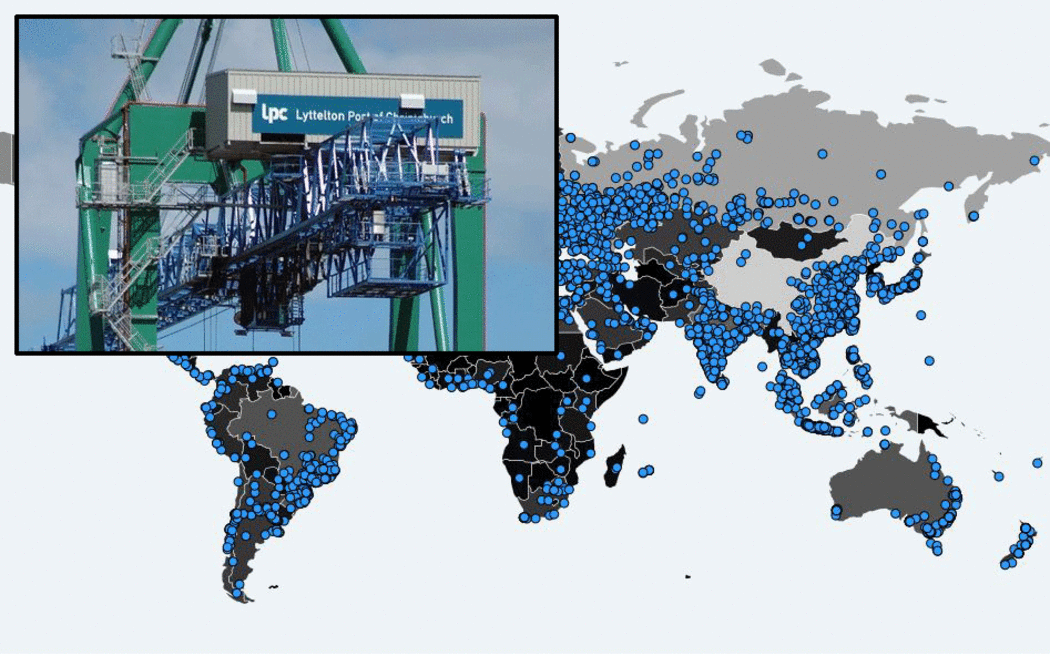Operations will stop at Christchurch's Lyttelton Port tomorrow night so it can work on protecting itself from the massive global ransomware attack known as WannaCry.

About 200,000 computers in more than 150 countries have been affected. Photo: RNZ / Screenshot
The virus has locked up about 200,000 computers in more than 150 countries, taking control of files and then demanding payment to restore access, and there are warnings those numbers could rise.
See the live tracking map of the virus here.
On its website, the council-owned company said it had scheduled an urgent systems outage that would affect the Container Terminal and Inland Ports and Depots.
It said it was vital it put measures in place to limit the risk of an attack on its IT systems.
The outage was scheduled for 11pm Tuesday until 7am Wednesday, during which operations would be suspended.
The port said no shipping services were scheduled during that period.
Officials are working to determine what level of exposure New Zealanders have had to the attack.
Computer Emergency Response Team (CERT) spokesperson Declan Ingram told Checkpoint with John Campbell that it was investigating reports from people who believed they had been hit, but it was still unclear at this stage how many had been affected.
"The difficulty can become... there's obviously not just one ransomware campaign happening at any one time, and so the media around this particular one has meant that others are reporting in other campaigns well."
Mr Ingram said it was serving as an awareness-raising exercise for members of the general public not previously aware of the dangers of ransomware.
"It's very good to get the preventative messages out there, not just to save people from this particular one, but from other information security problems as well," he said.
Despite the accidental discovery of a so-called kill switch for WannaCry on Saturday, the nature of ransomware has meant it has been difficult to stop it definitively.
"Unfortunately with these things, once you go through and kill one part of it then new variants come away and then it becomes a bit of a cat and mouse game with future variants of it," Mr Ingram said.
European Union cyber security expert, Robert Pritchard said he believed criminal gangs were responsible for the virus, and said they were unlikely to be caught.
"It requires multinational co-ordination because they could be in lots of different countries," he said.
"This has caused such devastation in the UK and lots of other countries as well, [but] I think part of the problem with rounding up these kind of gangs is that usually it's not a high enough of a priority for enough police forces at the same time for it to happen."
Microsoft criticises US government's role in attack
Microsoft said the latest cyber attack should be treated by governments around the world as a "wake-up call".
WannaCry exploits a flaw in Microsoft Windows first identified by US intelligence.
In a statement, the computing giant criticised the way governments stored up information about security flaws in computer systems - which could then be stolen, causing widespread damage.
It compared it to the US military having some of its Tomahawk missiles stolen.
How to protect yourself from a ransomware attack
- Always update your computer's operating system when new versions are available
- Make sure firewall and anti-virus software is up to date and fully operational
- Back up your data regularly on a device that is not connected to any network
- Be careful when opening emails - don't automatically trust emails from people you know
- Think before you open any attachments (even PDFs can be a risk)
- If you are the victim of a ransomware attack, report it via the CERT website






